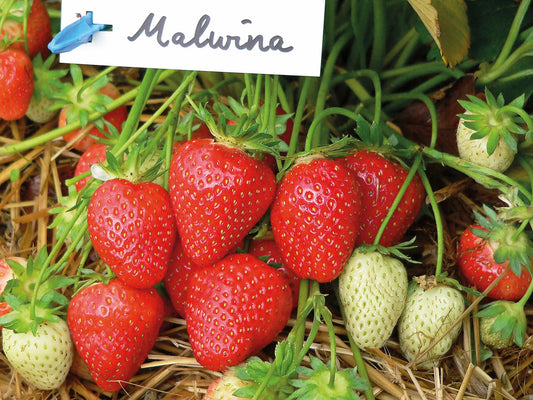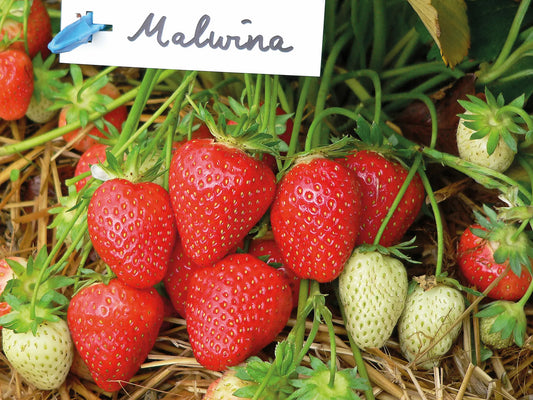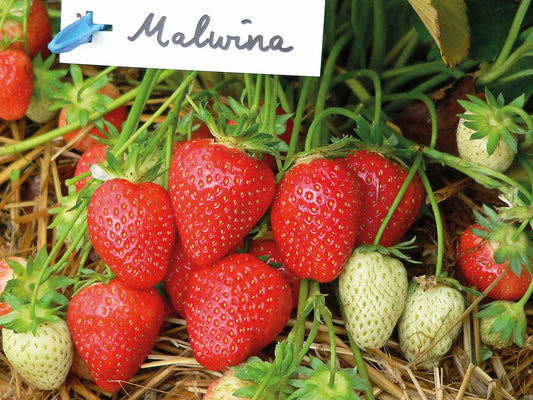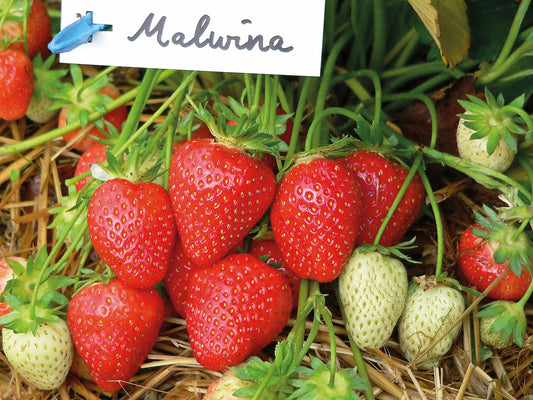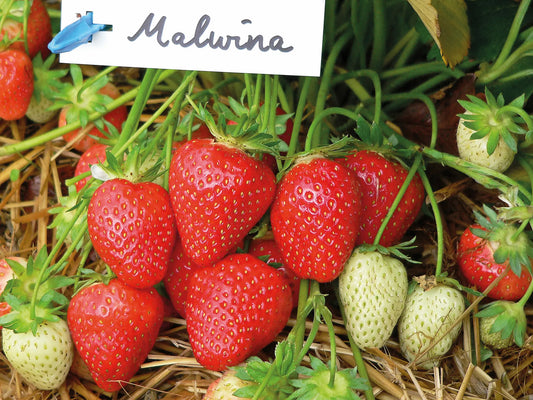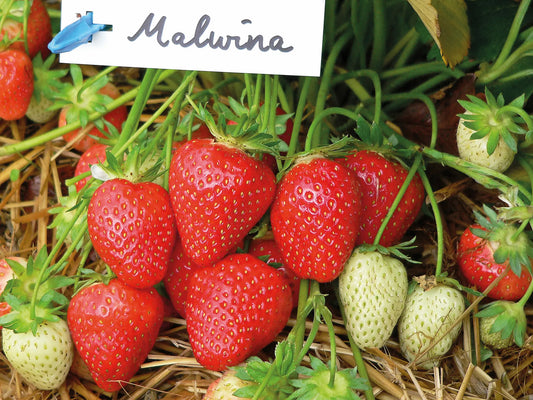-
Delivery from 10 plants to France, Switzerland and Europe
Delivery method -
Strawberry Plant Wholesale Supplier
About Us -
Quality Strawberry Plants
Strawberry technical itinerary -
Secure payment
Our Payment Terms
Malwina Waiting Bed Strawberry Plant 18-22 mm
Malwina Waiting Bed Strawberry Plant 18-22 mm
Price per unit (€ excluding VAT) excluding shipping. Our prices are based on volume. We offer you the best option based on your needs.
 - Add the desired date to your quote request
- Add the desired date to your quote request
- Buy now and get it delivered when you're ready to plant
- Delivery from 10 plants to France, Switzerland and Europe
Couldn't load pickup availability
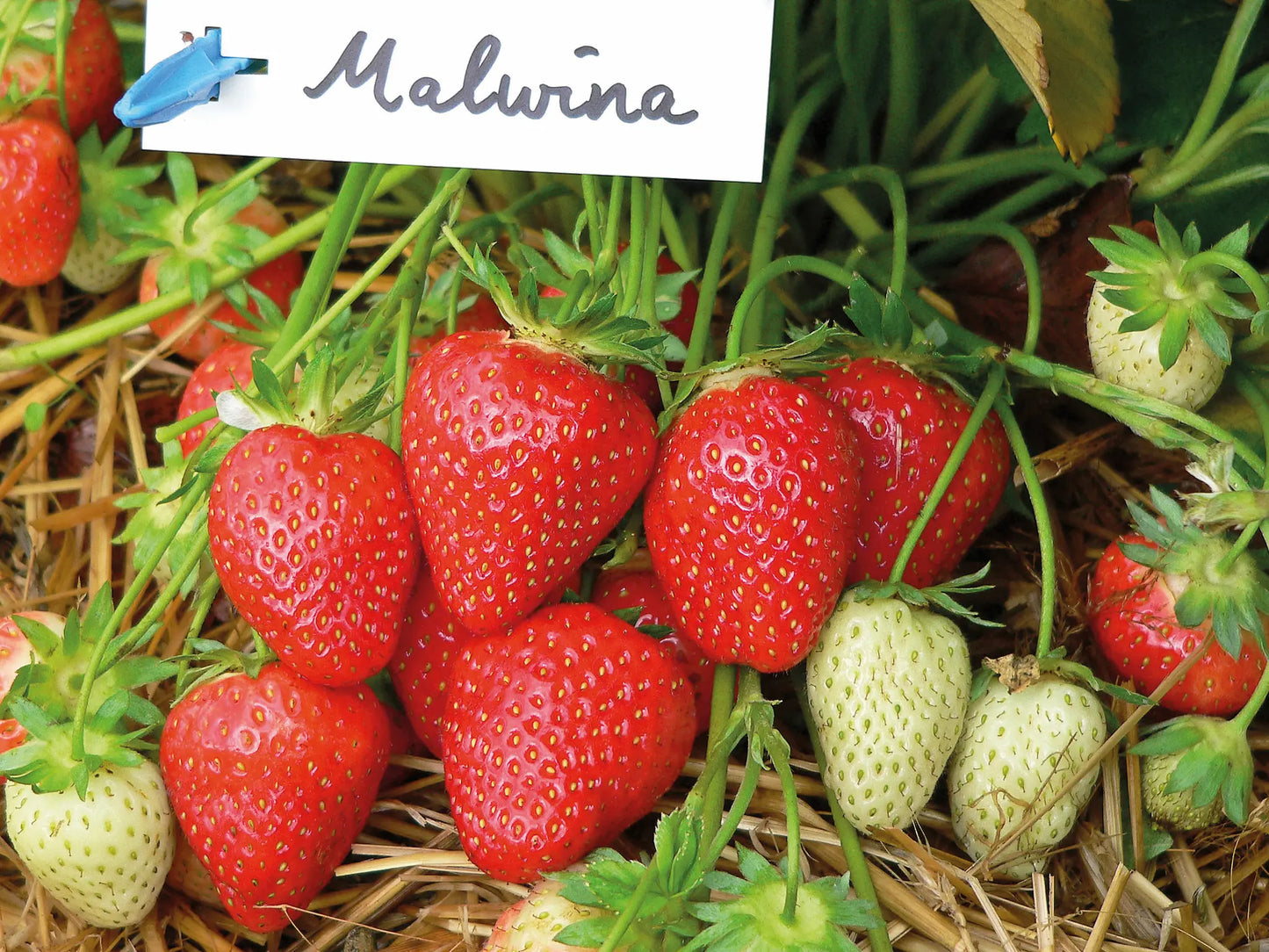
Collapsible content
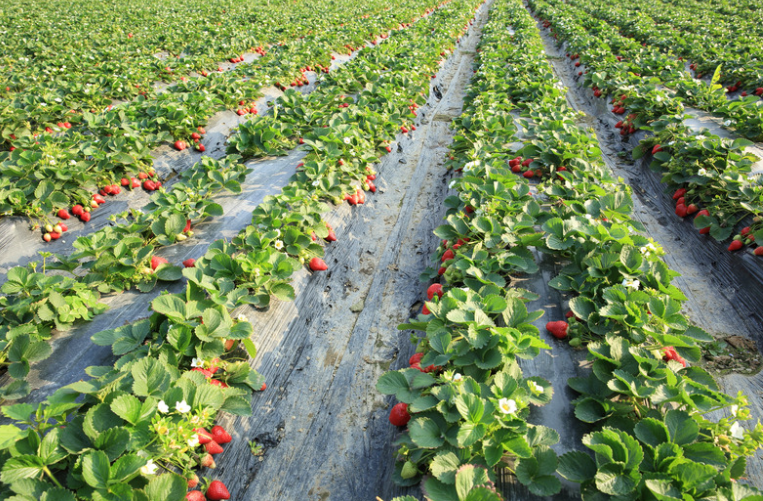
Strawberry Plant Buying Guide: What Type of Plants? For What Market Opportunity?
Which format should you choose: refrigerated, fresh, tray-plants, waiting bed, or plugs? Compare yields, costs, and harvest times at a glance.
Download the PDF guide (13 pages)
Why read this guide?
- Comparison tables: yield (300–600 g/plant), cost & labor.
- Reservation/delivery calendar for each format.
- Minimum order: 20 to 1,000 plants depending on the type.
- Full-field vs. above-ground case studies to maximize margin.
Overview of the 5 professional formats
Detailed comparison of formats
| Format | Yield (g/plant) |
Harvest time | Min. order | Average cost |
|---|---|---|---|---|
| Fridge | 250 – 400 | 120 days | 20 plants | 0.20 – 0.45 € |
| Costs | 280 – 420 | 140 days | 200 plants | 0.20 – 0.45 € |
| Tray plant | 400 – 600 | 90 days | 500 plants | 0.75 – 0.80 € |
| Waiting Bed | 300 – 500 | 105 days | 500 plants | 0.50 – 0.60 € |
| Motte | 230 – 350 | N+1 | 1,000 plants | 0.35 – 0.50 € |
Delivery schedule
| Plant type | Jan | Feb | Mar | Apr | May | Jul | Jul | Aug | Sep | Oct | Nov | Dec |
|---|---|---|---|---|---|---|---|---|---|---|---|---|
| Fridge | ||||||||||||
| Tray plants | ||||||||||||
| Waiting Bed | ||||||||||||
| Motte | ||||||||||||
| Costs |
Which format for which scenario?
Full field controlled budget
Fridge or Fresh : cost 2 x lower than tray plants, planting flexibility.
Above ground in greenhouse
Tray-plants : harvest 90 days after planting, uniform size, reduced labor.
Late planting
Mottes : planting July–August, rapid recovery, harvest the following year.
Ready to plan your plantings?
Download the complete guide Request a quoteFrequently Asked Questions
Is the guide free?
Yes, no fees or obligation to purchase.
How to download it?
Click the button “Download the guide” ; the PDF opens immediately.
Can I request a personalized quote?
Of course: write to us at contact@fraisiverse.com and an agronomist will respond to you within 24 hours.
Choosing the right strawberry varieties for your plot
Extend your harvest season by up to 5.5 months with our "early + season + everbearing" method. Compare 78 cultivars, sizes, and markets.
Download the PDF guide (17 pages)
4 axes to decide quickly
- Harvest Window : Early, Seasonal, or Everbearing? Combine them for 5.5 months .
- Commercial outlet : direct sales, long circuit, processing or freezing.
- Type of plants : fridge, fresh, root ball, tray plants… adapt your investments and your schedule.
- Growing conditions : open field, soilless, greenhouse; target consistent yield and size.
Axis 1: Select your harvest window
Example of recommended mix:
- Ciflorette (early) → Rubis des Jardins (season) → Charlotte (remontant).
- 5.5 months of continuous production, ideal for direct sales.
Axis 2: Sell at the right market
Direct sales
Ciflorette, Charlotte, Mara des Bois: premium taste sought after by consumers.
Long circuit / GMS
Magnum, Clery, Dream: uniform size, 95% class 1 fruit.
Transformation
Darselect, Mara des Bois – high sugar content and stable aroma.
Freezing
Honeoye, Belrubi – firm flesh, keeps well in the cold.
Axis 3: Choose the right type of plants
| Kind | Reservation | Delivery | Highlights |
|---|---|---|---|
| Fridge | All year round | Dec. → Aug. | Flexibility & price |
| Tray plants | Feb. → June | Nov. → Apr. | Above ground, harvest 90 days after planting |
| Motte | Sep. → May | Jul. → Sep. | Ideal for open fields, harvest N+1 |
| Costs | Feb. → Aug. | Sep. → Nov. | Young plants, rapid recovery |
Axis 4: Optimize your technical constraints
Tray plants guarantee +25% yield and simplified harvesting above ground; ideal for mechanizing your production and ensuring consistent size.
Frequently Asked Questions
Is the guide really free?
Yes, with no cost or obligation to purchase.
How to download it?
Just click the button “Download the guide” at the top of the page; the PDF opens immediately.
Can I request a personalized quote?
Of course: contact us via our contact page .
When to plant? When to harvest?
Do you want to start a strawberry farm but don't know when to reserve your plants, when to plant them or even harvest them?
Because we love 🍓 (with just a little sugar), we're going to do the work for you. On this page, you'll find the growing steps for each type of strawberry plant. When to order? What is the delivery period? When to plant? And finally, when to harvest?
Production Calendar - Frigo Strawberry Plants
| Production Calendar - Frigo Strawberry Plants | ||||||||||||||||||||||||
|---|---|---|---|---|---|---|---|---|---|---|---|---|---|---|---|---|---|---|---|---|---|---|---|---|
| Jan | Feb | Mar | Apr | May | Jun | Jul | Aug | Sep | Oct | Nov | Dec | |||||||||||||
| Reservation | ||||||||||||||||||||||||
| Deliverable | ||||||||||||||||||||||||
| Recommended planting | ||||||||||||||||||||||||
| Harvest | ||||||||||||||||||||||||
Production Calendar - Fresh Bare-Root Strawberry Plants
| Production Calendar - Bare Root Strawberry Plants | ||||||||||||||||||||||||
|---|---|---|---|---|---|---|---|---|---|---|---|---|---|---|---|---|---|---|---|---|---|---|---|---|
| Jan | Feb | Mar | Apr | May | Jun | Jul | Aug | Sep | Oct | Nov | Dec | |||||||||||||
| Reservation | ||||||||||||||||||||||||
| Deliverable | ||||||||||||||||||||||||
| Recommended planting | ||||||||||||||||||||||||
| Harvest | ||||||||||||||||||||||||
Production Calendar - Strawberry Plants Plugs
| Production Calendar - Strawberry Plants Motte | ||||||||||||||||||||||||
|---|---|---|---|---|---|---|---|---|---|---|---|---|---|---|---|---|---|---|---|---|---|---|---|---|
| Jan | Feb | Mar | Apr | May | Jun | Jul | Aug | Sep | Oct | Nov | Dec | |||||||||||||
| Reservation | ||||||||||||||||||||||||
| Deliverable | ||||||||||||||||||||||||
| Recommended planting | ||||||||||||||||||||||||
| Harvest | ||||||||||||||||||||||||
Production Calendar - Strawberry Plant Tray
| Production Calendar - Strawberry Plants Motte | ||||||||||||||||||||||||
|---|---|---|---|---|---|---|---|---|---|---|---|---|---|---|---|---|---|---|---|---|---|---|---|---|
| Jan | Feb | Mar | Apr | May | Jun | Jul | Aug | Sep | Oct | Nov | Dec | |||||||||||||
| Reservation | ||||||||||||||||||||||||
| Deliverable | ||||||||||||||||||||||||
| Recommended planting | ||||||||||||||||||||||||
| Harvest | ||||||||||||||||||||||||
Our Growing Guides by Plant Type / Our Growing Tips
Our online advisor: Fraisibot
Our technical itineraries by type of strawberry plant:
Technical Itinerary for Growing Strawberries from Frigo Plants
Technical Itinerary for Growing Strawberries from Plug/Pod Plants
Technical Instructions for Growing Strawberries from Tray or Mini Tray Plants
Technical Guide for Growing Strawberries from Bare-Root Fresh Strawberry Plants
Technical Instructions for Growing Strawberries from Waiting Bed Plants
All our growing tips for planting strawberries:
Strawberry Plants: Soil Preparation and Planting
Soil preparation for strawberry growing, planting techniques, and optimizing strawberry yield.
Best Practices for Irrigation and Fertilization of Strawberry Plants
Efficient irrigation systems, frequency and quantity of watering, types of fertilizers and application times, signs of nutritional deficiencies, growing strawberries in substrate, protection against frost and diseases.
Protection and Prevention of Strawberry Diseases and Pests
The main diseases and pests affecting strawberries, as well as effective methods for their prevention and treatment, including biological control and the use of resistant varieties. It provides practical advice for maintaining healthy and productive strawberry crops.
Succeeding in Strawberry Farming: Costs, Business Strategy and Subsidies
Growing strawberries requires significant initial and ongoing costs, but with effective marketing strategies and sustainable practices, growers can maximize their profits while contributing positively to the environment. Grants and financial aid are available to support necessary investments and encourage environmentally friendly farming practices.
Maximizing Strawberry Harvest and Storage: A Practical Guide
How to determine the optimal time to harvest strawberries, best practices for minimizing fruit damage during picking, and effective methods for storing and managing unsold strawberries to avoid losses and maximize profitability. It offers practical tips for extending the shelf life of strawberries, including refrigeration, freezing, and dehydration.
Strawberry Growing: Why Stagger Production? Early, Seasonal, Late? How to Choose?
Staggering strawberry production allows for harvests to be spread throughout the season, ensuring optimal fruit quality and increased profitability. Learn about recommended varieties for early, mid-season, and late-season production, as well as best practices for harvesting and storage.
Malwina strawberry variety technical sheet
- Remontant: Non-Remontant
- Precocity: very late
- Harvest period: August-September
- Shape, texture, appearance of the Fruit: Little deformation,
- Fruit color: Very bright
- Taste characteristics: Very sweet if picked ripe
- Fruit Size: Very sweet if picked ripe
- Disease resistance: Low susceptibility to disease. Tolerant to Vertilicum. Low susceptibility to rot.
- Performance, management and marketing: Good performance. 90% of Elsanta
- Recommended commercial use / marketing channel: Direct sales, Wholesale, Processing
Order your professional strawberry plants
Fraisiverse, a specialist wholesale supplier of strawberry plants , offers you the Malwina variety, known for its very late maturity and exceptional fruit quality. Buying your strawberry plants guarantees you a supply of plants from specialized nurseries, at producer prices and of professional quality . Benefit from high varietal resistance , high yield and increased tolerance to diseases to optimize your harvests. Our teams offer you personalized advice and dedicated technical support to adapt your plantations to your objectives. Fast and careful delivery throughout France , with decreasing prices according to your volumes. Order your plants now to guarantee a successful production season and optimal spread of your sales. Reserve now or request a free quote to take advantage of the best conditions.
Varietal characteristics and morphological properties
The Malwina strawberry plant is recognized as a non-remontant variety, distinguished by its very late production . Its fruit, with a particularly attractive visual presentation, has a dark red to bright red exterior color, uniform and deep. The flesh, for its part, is a deep red, often slightly lighter than the skin, but always perfectly colored, without the presence of a white heart or pale areas .
Regarding the size, Malwina produces very large fruits , with an average weight frequently observed between 40 and 50 grams . In fact, approximately 85% of its fruits are large in size , displaying a conical shape, notable firmness and excellent resistance to bad weather. These fruits are also very shiny, with a smooth and thin skin, ensuring very good shelf life and increased resistance to handling. The consistency of the flesh is both very firm and juicy , qualities that make it ideal for transport and storage. In terms of taste, Malwina offers a very sweet and intense flavor , with a pronounced aroma, and fragrant flesh. Its hardiness is also a major asset, conferring strong resistance to diseases and good resistance to adverse conditions.
Cultivation techniques and nutritional management
To fully exploit the potential of the Malwina strawberry, rigorous cultural management is essential. It is imperative to require a rich, well-drained and slightly acidic soil , with a pH ideally between 6 and 6.5 .
Fertilization program
Basal fertilization is essential, with a recommended application of 80 to 120 units of nitrogen (N) per hectare , 80 to 100 units of phosphorus (P₂O₅) and 150 to 180 units of potash (K₂O) annually. A split application strategy is recommended: half of the nitrogen, all of the phosphorus and 70% of the potash are incorporated before planting, preferably in autumn or early spring, in the form of natural organic or mineral fertilizers. Incorporating 30 to 40 tonnes per hectare of well-rotted manure or compost , 3 to 4 months before planting, is crucial to enrich the soil with organic matter (aim for a rate above 2%) and prevent excess salinity. The remaining nitrogen and potash are applied as maintenance in the spring, at the start of the growing season (March-April), split into two applications spaced three weeks apart if necessary. It is important to avoid excess nitrogen, which could harm fruiting and increase the risk of fungal diseases.
Trace elements and irrigation
Trace element intake should also be monitored: magnesium (30 to 40 units/ha) and calcium (80 to 120 units/ha) are particularly important, as is boron (1 to 2 kg/ha) for fruit set. Regular watering is essential during growth and fruiting, especially on light soils.
Renewal of plantations
Regarding productive lifespan, it is generally recommended to renew plantations every 3 years in intensive cultivation, in order to maintain regular production and optimal quality. Beyond this period, vigor, fruit size and health resistance decrease significantly. Renewal by whole beds is preferable to avoid the persistence of pathogenic sources, and the systematic use of stolons from old plants for replanting should be avoided.
Productive potential and harvest planning
The Malwina strawberry plant, although late, offers a very satisfactory yield for professionals. The average yield per plant is estimated between 700 grams and more than 1 kilogram in good growing conditions. Projected on a hectare scale, with a classic planting density of 40,000 to 50,000 plants/ha , this represents a production potential of 28 to 35 tonnes per hectare for an average of 700 g/plant, which can reach 40 to 50 tonnes per hectare in optimal conditions with a yield of 1 kg/plant.
Harvest period and timing
Malwina is a very late variety , significantly extending the harvest season. Its production generally extends from the end of July to mid-August , or even from the end of June to mid-July according to other sources. It is considered one of the last varieties to produce, thus offering the possibility of spreading the supply to the markets. Production is spread over more than 20 days , and the rate of unmarketable fruit remains very low, less than 5% , which ensures excellent value for the harvest.
Phytosanitary protection and resistance to pests and diseases
The Malwina strawberry plant is distinguished by its strong resistance to major strawberry diseases , a considerable asset for growers keen to limit inputs and adopt more sustainable practices. The variety is known for its very good resistance to Botrytis (grey fruit rot), Verticillium (Verticillium wilt), Anthracnose and Phytophthora (red crown). Its overall robustness contributes to a healthy and vigorous plant.
Pest management
For common pests such as thrips, aphids, spider mites, weevils (Anthonomus) or Drosophila suzukii, the sources do not provide specific resistance data for Malwina. For these pests, the management strategy is therefore based on classic integrated pest management methods , including regular monitoring, the use of natural auxiliaries and, if necessary, targeted interventions. The robustness of the Malwina variety, however, reduces the need for phytosanitary treatments in general.
Commercial aspects and post-harvest logistics
The firmness of Malwina's flesh and its juiciness make it ideal for transport and storage, which is a major logistical advantage for professionals. The variety offers excellent post-harvest shelf life , which limits losses and ensures flexibility in marketing.
Opportunities and development
Primarily intended for fresh consumption , Malwina is perfectly suited to direct sales in local markets, restaurants or pastry shops, where its taste qualities and visual appearance are highly valued. The high percentage of large-sized fruits (around 85%) facilitates their packaging and transport for fresh sale. Although its productivity is described as average, the exceptional quality of the fruits more than compensates for this characteristic, making it a strategic choice for spreading production late in the season. Malwina is also highly valued for freezing and culinary preparations , particularly jams, thanks to its good stability and aromatic richness after cooking. This versatility, combined with its high proportion of first-class fruits ( over 95% when packaged ), guarantees excellent profitability.
Field feedback and professional expertise
Feedback from growers highlights the robustness of the Malwina variety and its ability to maintain good growth even in difficult conditions. Its strong resistance to diseases, particularly Verticillium and fruit rot, is regularly cited as a key factor in its reliability in cultivation. Despite productivity sometimes described as average compared to other varieties, the intrinsic quality of Malwina fruit is unanimously praised, making it a preferred choice for demanding end-of-season markets. Its ability to be frozen without significant alteration of flavor makes it an asset for diversifying outlets, such as culinary preparations.
To summarize: Our Malwina strawberry plants
At Fraisiverse , we provide professionals with the Malwina variety, specially selected for its late production and superior quality. As a specialist wholesale supplier of strawberry plants , we offer vigorous plants from specialized nurseries, guaranteeing an optimal start to your crop. Choosing our offer means opting for a deep red, shiny fruit with firm and sweet flesh, appreciated for its conservation and resistance to transport. Experienced producers know that buying Malwina strawberry plants allows you to obtain a high size (up to 50 g), a natural resistance to major diseases such as Botrytis and Verticillium, and a yield of up to 40 to 50 tons/ha in optimal conditions. Thanks to our experience, our efficient logistics and our technical support, buying Malwina strawberry plants becomes a safe investment to make your plot profitable at the end of the season. Trust our expertise as a specialist wholesale supplier of strawberry plants to provide you with a high-performance and sustainable solution. With Fraisiverse , you benefit from healthy plants, complete traceability and personalized follow-up for each order. Therefore, buying Malwina strawberry plants with us means choosing quality, consistency and guaranteed growing success thanks to a specialist wholesale supplier of strawberry plants recognized by professionals.
-
Malwina Frigo A- Strawberry Plant
Regular price €0,17 EURRegular priceUnit price / per -
Malwina Frigo A Strawberry Plant
Regular price €0,18 EURRegular priceUnit price / per -
Malwina Fresh Bare-Root Strawberry Plant
Regular price €0,20 EURRegular priceUnit price / per -
Malwina Frigo A+ Strawberry Plant
Regular price €0,26 EURRegular priceUnit price / per -
Malwina Potted Strawberry Plant
Regular price €0,27 EURRegular priceUnit price / per -
Malwina Frigo A++ Strawberry Plant
Regular price €0,32 EURRegular priceUnit price / per





